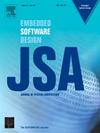ARES: Adaptive robust object detection framework for enhancing real-time performance in autonomous vehicle systems
IF 4.1
2区 计算机科学
Q1 COMPUTER SCIENCE, HARDWARE & ARCHITECTURE
引用次数: 0
Abstract
In contemporary autonomous vehicles, object detection must provide both robust detection against threats like adversarial patch attacks and timely execution to meet real-time deadlines. Certifiably robust detection, also known as patch-agnostic approach, meets the first requirement. However, it introduces significant computational overhead, thereby compromising its real-time performance. To resolve this conflict, we propose ARES, a novel framework inspired by mixed-criticality systems. ARES introduces a security-driven paradigm. By default, the framework operates in a high-performance, low-security mode. However, it transitions to a high-security mode, utilizing a computationally intensive and robust detector, only when an active attack is detected. This selective activation is managed by the ARES transition manager, which captures the attack timing and handles tasks during mode transition. The ARES scheduling framework, on the other hand, guarantees formal schedulability analysis and optimal priority assignment. In our experiments, ARES demonstrated an increase of up to 8.9 in overall FPS detection over baseline. Furthermore, when evaluating the acceptance ratio with randomly generated task sets, ARES exhibited a 40.8–62.9% enhancement in schedulability compared to baseline.
ARES:用于增强自动驾驶车辆系统实时性的自适应鲁棒目标检测框架
在当代自动驾驶汽车中,目标检测必须既能提供针对对抗性补丁攻击等威胁的强大检测,又能及时执行以满足实时截止日期。可证明的鲁棒检测,也称为补丁不可知方法,满足第一个要求。然而,它引入了大量的计算开销,从而损害了其实时性能。为了解决这一冲突,我们提出了ARES,这是一个受混合临界系统启发的新框架。ARES引入了一个安全驱动的范例。默认情况下,框架以高性能、低安全性模式运行。但是,只有在检测到主动攻击时,它才会转换为高安全性模式,利用计算密集型和健壮的检测器。这种选择性激活由ARES转换管理器管理,它捕获攻击时间并在模式转换期间处理任务。另一方面,ARES调度框架保证了正式的可调度性分析和最优优先级分配。在我们的实验中,ARES在总体FPS检测上比基线提高了8.9倍。此外,当评估随机生成任务集的接受率时,ARES在可调度性方面比基线提高了40.8-62.9%。
本文章由计算机程序翻译,如有差异,请以英文原文为准。
求助全文
约1分钟内获得全文
求助全文
来源期刊

Journal of Systems Architecture
工程技术-计算机:硬件
CiteScore
8.70
自引率
15.60%
发文量
226
审稿时长
46 days
期刊介绍:
The Journal of Systems Architecture: Embedded Software Design (JSA) is a journal covering all design and architectural aspects related to embedded systems and software. It ranges from the microarchitecture level via the system software level up to the application-specific architecture level. Aspects such as real-time systems, operating systems, FPGA programming, programming languages, communications (limited to analysis and the software stack), mobile systems, parallel and distributed architectures as well as additional subjects in the computer and system architecture area will fall within the scope of this journal. Technology will not be a main focus, but its use and relevance to particular designs will be. Case studies are welcome but must contribute more than just a design for a particular piece of software.
Design automation of such systems including methodologies, techniques and tools for their design as well as novel designs of software components fall within the scope of this journal. Novel applications that use embedded systems are also central in this journal. While hardware is not a part of this journal hardware/software co-design methods that consider interplay between software and hardware components with and emphasis on software are also relevant here.
 求助内容:
求助内容: 应助结果提醒方式:
应助结果提醒方式:


